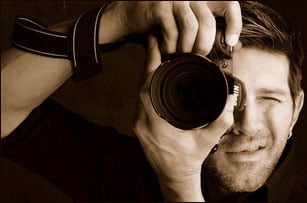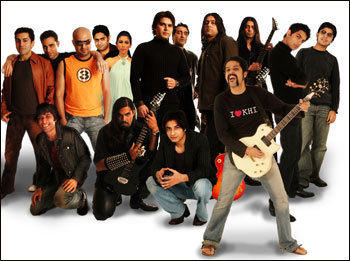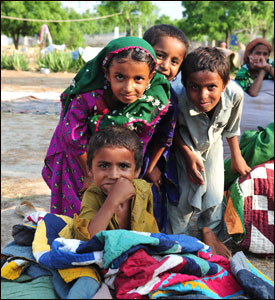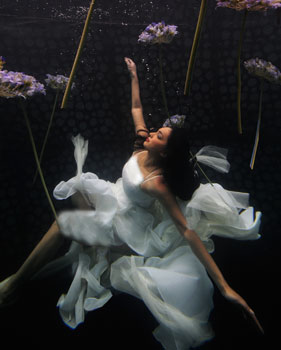 You’re likely to see Tapu Javeri at every fashion event worth
its mettle. Standing in the dark recesses beyond the glitzy catwalk,
he clicks, seeking to capture with his camera not just the clothes
nor just the models, but a rare moment … the diaphanous flow
of fabric as a model turns around, the exquisite trailing drape of
a sari or an audience enraptured by an extraordinary outfit. Even
when he’s photographing an ad campaign or a portrait, Tapu
seeks to be different. Why shoot aboveground when you can go underwater?
Why photograph Ali Azmat directly when you can have him peer into
a fishbowl instead? Why plan out a straightforward fashion shoot
when you can dress up the models instead as ‘Babydoll Bandits’ and
construct a comic-strip style story around them. That’s Tapu
Javeri for you when he’s photographing the stars. He plays
with lights, invents surreal scenarios and experiments around with
strange props. Very saucy, very tongue-in-cheek, very Tapu, very
delicious or – as the title of his new book succinctly puts
it – very ‘Tapulicious’. You’re likely to see Tapu Javeri at every fashion event worth
its mettle. Standing in the dark recesses beyond the glitzy catwalk,
he clicks, seeking to capture with his camera not just the clothes
nor just the models, but a rare moment … the diaphanous flow
of fabric as a model turns around, the exquisite trailing drape of
a sari or an audience enraptured by an extraordinary outfit. Even
when he’s photographing an ad campaign or a portrait, Tapu
seeks to be different. Why shoot aboveground when you can go underwater?
Why photograph Ali Azmat directly when you can have him peer into
a fishbowl instead? Why plan out a straightforward fashion shoot
when you can dress up the models instead as ‘Babydoll Bandits’ and
construct a comic-strip style story around them. That’s Tapu
Javeri for you when he’s photographing the stars. He plays
with lights, invents surreal scenarios and experiments around with
strange props. Very saucy, very tongue-in-cheek, very Tapu, very
delicious or – as the title of his new book succinctly puts
it – very ‘Tapulicious’.
However, that’s not all there is to Tapu the photographer.
He’s been archiving fashion from the days of yore when all
we had were a handful of glossies but he also has a penchant for
photographing his surroundings. A wanderer with an insatiable camera,
he photographs anything he finds interesting, may it be a quirky
billboard or a motorbike shuddering under the weight of its many
passengers. But there’s no hint of derision in Tapu’s
work. He’s clearly very patriotic and more often than not,
he’ll be there at any event, celebration or even disaster,
chronicling Pakistani history for posterity with his camera. He goes
to Sea View every August 14 to capture images of hordes of revelers
as they zoom by on their motorbikes, waving the national flag. He
photographs the masses of devotees visiting the shrine at Sehwan.
He meanders all over the city and, in the process, photographs Karachi’s
skyline, a bird’s eye view of Abida Parveen performing, the
view from atop the Hill Park, a hustling bustling Empress Market
and an entourage of coolies at the Cantt station – a series
of photographs that eventually became part of his photo exhibition
last year, titled ‘Kolachiscope’.
 More recently, Tapu visited Dadu, Sehwan and the surrounding areas – regions
completely devastated by floods. The photographs he has brought back
with him are heartrending – a child with his face completely
covered with houseflies; a boat floating aimlessly in an unlimited
expanse of muddy green water; a starving village cut off from food
supplies by flood water … “The conditions there are
terrible,” Tapu tells me. “Even in places where relief
camps have managed to distribute rations, people are barely managing
to survive. Tents that can generally only hold about eight people
are providing shelter to as many as 35 individuals. My friends and
I went with rations for about 4000 but in Sehwan only, 7000 people
were stranded. We distributed rations by word of mouth. We would
be told that a cluster of homes were stranded in a particular direction.
On reaching there by boat, we would discover entire families taking
shelter on the first floors of their homes while the ground floor
rotted away in water. And then there are the flies and mosquitoes.
The entire region is infested with them. I would be distributing
food packets when I’d suddenly look down and discover that
insects were buzzing all over my arm.” More recently, Tapu visited Dadu, Sehwan and the surrounding areas – regions
completely devastated by floods. The photographs he has brought back
with him are heartrending – a child with his face completely
covered with houseflies; a boat floating aimlessly in an unlimited
expanse of muddy green water; a starving village cut off from food
supplies by flood water … “The conditions there are
terrible,” Tapu tells me. “Even in places where relief
camps have managed to distribute rations, people are barely managing
to survive. Tents that can generally only hold about eight people
are providing shelter to as many as 35 individuals. My friends and
I went with rations for about 4000 but in Sehwan only, 7000 people
were stranded. We distributed rations by word of mouth. We would
be told that a cluster of homes were stranded in a particular direction.
On reaching there by boat, we would discover entire families taking
shelter on the first floors of their homes while the ground floor
rotted away in water. And then there are the flies and mosquitoes.
The entire region is infested with them. I would be distributing
food packets when I’d suddenly look down and discover that
insects were buzzing all over my arm.”
Tapu and his friends intend to return soon, with more supplies. “This
time around, along with food, we’re also planning to take some
cooking utensils, tarpaulin sheets that can act as hoods and mosquito
nettings for the large number of babies that have been born during
the floods.
There are so many areas where people are stranded but help hasn’t
even reached them yet. We’re planning to travel a little further
and see if there are more people there.”
As he gathers resources for his next trip, the extremely sad photographs
he has taken so far are already making the rounds. We all know of
the havoc wreaked by the floods but Tapu’s poignant images
only make the truth hit harder. With his knack for capturing just
the right moment with just the right details, his images speak a
thousand words. There is no need for text, the distressing expressions
on the flood victims’ faces say it all.
 But then again, that’s Tapu’s speciality – his
photographs are prolific enough without the need of any explanatory
text. On a lighter note, take his book Tapulicious for instance.
The book chronicles Tapu at his spiciest, edgiest, hypnotic best,
chalking out his journey as photographer to the stars. There’s
an image of a raunchy burka clad Anita Ayub with her legs bared,
Babra Sharif posing a la Marilyn Monroe, Aaminah Haq floating underwater
for an Ammar Belal ad, Arshad Mehmood staring dismally into the far
distance, a psychedelic album cover for Mauj where Omran Shafique
poses both as the male as well as the female ‘village belle’ counterpart
and a black and white portrait of an ailing Mehdi Hasan among others.
Each photograph is unique, seeking to encapsulate a moment, portray
a characteristic, tell a story … without any words. But then again, that’s Tapu’s speciality – his
photographs are prolific enough without the need of any explanatory
text. On a lighter note, take his book Tapulicious for instance.
The book chronicles Tapu at his spiciest, edgiest, hypnotic best,
chalking out his journey as photographer to the stars. There’s
an image of a raunchy burka clad Anita Ayub with her legs bared,
Babra Sharif posing a la Marilyn Monroe, Aaminah Haq floating underwater
for an Ammar Belal ad, Arshad Mehmood staring dismally into the far
distance, a psychedelic album cover for Mauj where Omran Shafique
poses both as the male as well as the female ‘village belle’ counterpart
and a black and white portrait of an ailing Mehdi Hasan among others.
Each photograph is unique, seeking to encapsulate a moment, portray
a characteristic, tell a story … without any words.
I meet Tapu shortly after his return from Dadu and as we flip through
the 115-paged hardbound glossy, it turns out that many of the anecdotes
behind the photographs are just as interesting as the actual images. “I
made molds out of Aaminah Haq’s face for this particular photograph,” he
says, pointing to an image where Aaminah poses for a make-up ad,
surrounded by clay masks. “I still have one of these masks
with me.” He points to a nondescript mask hanging from a wall
inside his jewelry shop which is apparently a mold of Aaminah’s
face, though you wouldn’t know it!
 Aaminah Haq, actually, features quite regularly in Tapulicious. “I
have done some of my best work with Aaminah,” explains
Tapu. “Models like her and Iraj have always been fun to work
with because they are willing to push the boundaries and experiment.” One
particularly noticeable photograph of Aaminah is of her floating
underwater, an eerie, entrancing image that, it turns out, nearly
cost Tapu his life. “Ammar wanted me to photograph Aaminah
while she was underwater and he built me this big waterproof metal
box that could be lowered into the pool,” he recalls. “I
was supposed to take photographs from a window in the box. We rehearsed
the shoot on the first day and everything went well. On the second
day, we began to shoot from the morning on but as time passed, I
started feeling claustrophobic. Aaminah Haq, actually, features quite regularly in Tapulicious. “I
have done some of my best work with Aaminah,” explains
Tapu. “Models like her and Iraj have always been fun to work
with because they are willing to push the boundaries and experiment.” One
particularly noticeable photograph of Aaminah is of her floating
underwater, an eerie, entrancing image that, it turns out, nearly
cost Tapu his life. “Ammar wanted me to photograph Aaminah
while she was underwater and he built me this big waterproof metal
box that could be lowered into the pool,” he recalls. “I
was supposed to take photographs from a window in the box. We rehearsed
the shoot on the first day and everything went well. On the second
day, we began to shoot from the morning on but as time passed, I
started feeling claustrophobic.
“I felt as if the walls were closing in around me. At around three in
the afternoon, I asked my assistant to pull me out because I was feeling uncomfortable.
I had only been out for a minute or so when the box suddenly collapsed. A chair
had been placed inside it for me and it became completely bent out of shape.
That was my one and only near-death experience as a photographer – thankfully!” he
laughs.
Near death experiences aside, Tapu’s work as a photographer
involves quite a few hurdles. He braves mosquito bites when he photographs
Dadu’s flood ridden terrain. As photographer to the stars,
he deals with tantrums and fragile egos. “You have to be very
diplomatic and patient,” he agrees. “As in any other
profession, you have to please your client.” As a case in point,
he shows me a photograph spread out over two pages, featuring the
crème de la crème of Pakistani music standing in a
single row. “In this shot, Ali Azmat was in the centre while
Haroon and Fakhir were on either side of him. Now, Ali wanted to
stay in the centre but both Fakhir and Haroon wanted to stand on
the same side because they felt that their faces photographed better
from that particular angle. They squabbled for a long time and Ali
finally exploded that no wonder Awaz broke up – Haroon and
Fakhir probably couldn’t even agree on left stage and right
stage,” chortles Tapu. In the photograph that was eventually
taken – the one featured in Tapulicious – both Fakhir
and Haroon stand side by side next to Ali with their heads tilted
at similar angles.
With a vast array of Pakistan’s glitterati included in ‘Tapulicious’,
I ask Tapu what people’s reactions have been to see their photographs
included? “A lot of people have called me up and thanked me,” he
replies. “Only a few days ago, Samina Peerzada called me and
told me that the shots I have included of her had actually managed
to land her an offer from Hollywood. She had subsequently refused
and she said to me, ‘Only think Tapu, where would I have been
if I had accepted!’”
 On the other hand, there are individuals that have been sidelined – most
of the new lot of models aren’t in the book at all though Tapu
has worked with them plenty of times. “Most of the new models
don’t excite me,” he shrugs. “They aren’t
focused enough since they’re also delving into other careers
like acting. Now models like Vinny, Iraj, Tanya Shafi … they
are the pioneers of Pakistani fashion. They are our very own supermodels
and they are all there in the book. I’ve had people complain
that I haven’t included their photographs. I tell them all
that I’ll include them in the next volume, which will focus
completely on my work in fashion.” On the other hand, there are individuals that have been sidelined – most
of the new lot of models aren’t in the book at all though Tapu
has worked with them plenty of times. “Most of the new models
don’t excite me,” he shrugs. “They aren’t
focused enough since they’re also delving into other careers
like acting. Now models like Vinny, Iraj, Tanya Shafi … they
are the pioneers of Pakistani fashion. They are our very own supermodels
and they are all there in the book. I’ve had people complain
that I haven’t included their photographs. I tell them all
that I’ll include them in the next volume, which will focus
completely on my work in fashion.”
Tapu’s plans for a new book are rather valiant. Tapulicious
may have been lauded by critics but he has no high expectations of
it selling well. “People here don’t believe in buying
books. Both Kiran Aman, the publisher of Tapulicious, and I know
that,” he reveals. “Still, we wanted to archive these
photographs and bring them into book form. As it is, photography
doesn’t pay much – unless you’re a wedding photographer.
I hardly ever get paid for my work – designers just give me
clothes instead!”
Profits or no profits, Tapu’s new book, whenever it does come
out, is bound to be a dynamic ride through the many echelons of Pakistani
fashion. Tapu’s been around for a while – “I was
there when Safinaz (of Sana Safinaz) was a model,” he says
in explanation for how long he’s been in the business – and
a book on fashion photography by him is sure to portray Pakistani
fashion history in all its glory in a quintessentially Tapu, psychedelic
way. While his fashion shoots are often pure, unadulterated fun,
his work in the recent spate of fashion weeks has also been appreciable.
He has been there at every fashion week, from one city to the other,
diligently archiving entire collections with his camera. I ask him
whether he feels that there should just be one fashion week to which
he replies, “I don’t think so. Eventually, the events
that are better organized will continue on while others will just
dwindle away. Besides, with so many designers on board, if there
was just one fashion week, the event may have to last for as long
as 10 days. At least this way, we manage to get done in five or six
days.”
Diplomatic photographer that he is, Tapu doesn’t believe in
camps and insists that he prefers to work with whoever he pleases. “People
like my work which is why they want me photograph their collections,” he
opines. “It has nothing to do with who I am friends with. And
I’ve never been ousted from an event just because I worked
with so and so. I enjoyed attending all the different fashion weeks
but having said that, Karachi is my city and since most of my friends
are here, I had more fun at KFW.”
Fun and a sense of adventure it seems, is the key word behind Tapu’s
work ethos. His day job as a jeweler allows him carte blanche to
photograph at his will, without any money worries. Photography is
Tapu’s way to navigate the world and it opens new worlds to
him. He gets one high from sensuality and another from Sehwan. The
results are creative, vivacious images that leave you transfixed. |

